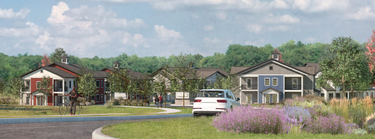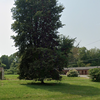Town board backs affordable-housing project, bypassing moratorium
— Photo from Homes and Community Renewal
Hudson on Nine, with 60 units opening in Bethlehem, was cited by P. Christopher Dirr as being similar to what he hopes to build in Guilderland.
GUILDERLAND — By a unanimous vote, the Guilderland Town Board on June 3 granted an exception to its building moratorium in order to allow a project with 72 units of affordable and workforce housing to proceed.
The project on Mercy Care Lane would depend on funding from the state’s Homes and Community Renewal agency, which has an application deadline in the fall, P. Christopher Dirr, a principal with Rockabill Consulting, based in Buffalo, explained to the board.
A moratorium on large-scale residential projects was adopted in May of last year. The board in March adopted a second moratorium as it reviews an update to the town’s two-decades-old land-use plan.
Members of the development team for the complex — which includes developer Rockabill, engineering firm LaBella, and site owner First Columbia — met with the Guilderland’s Development Planning Committee in December, when no formal application had been submitted to the town.
Only one citizen spoke at the public hearing and all five board members were uniformly enthusiastic about the project, citing the need for affordable and workforce housing in town.
Robyn Gray, who chairs the Guilderland Coalition for Responsible Growth, objected to part of the project being three stories high. “There’s nothing in that area that is three stories high,” said Gray, adding, “It’s definitely out of character with the neighborhood.”
“If I were only approved to do two stories, I couldn’t do this site,” said Dirr.
“So it’s about money,” retorted Gray.
“It’s not about money,” Dirr responded. “I don’t make a lot of money doing this.” He said he was motivated by a commitment to affordable housing.
He also said the site is “very walkable to a lot of amenities,” naming the public library, school, and retail shops on Western Avenue as well as public transportation.
Supervisor Peter Barber said that Saint Peter’s Addiction Recovery Center, known as SPARC, at 3 Mercy Care Lane, is three stories.
Barber also said, “If you’re going to lop off a floor because two is less than three, then you might have to say goodbye to the project because, in the end, you don’t have the density required.”
The site had previously been approved for the 65-unit Beacon Meadows, which was to become Guilderland’s first development for people aged 55 and older, adoptive families, and young adults with developmental disabilities.
Gray cited the Beacon Meadows project and asked, “Why is it that they were able to manage two stories and you can’t?”
Dirr responded, “Because they were building within the wetland setback areas.”
The state’s Department of Environmental Conservation has recently adopted more stringent rules to protect wetlands.
Stuart Mesinger with LaBella said, “The prior project is spread out all over the place with a lot more site disturbance … This one goes up a little higher. It gets you density, becomes more affordable.”
He also said, “The underlying zoning allows a maximum height of 35 feet. These would be about six feet higher … We’re not, like, super out of scale of what’s allowed anyway.”
The proposal
If the developer is successful in getting funding from Homes and Community Renewal — which Dirr described as “the primary mover that will bring in other funding that enables the development to proceed” — the earliest construction could start would be in July of 2026.
The developer would submit for a planned unit development, or PUD, for which the town board is the lead agency. The project would include a series of three-story walk-up buildings, a series of town homes, a clubhouse, and a maintenance garage.
“We have mimicked the site design that was previously followed by Beacon,” said Dirr, adding that changes were necessitated because of wetland areas bisecting the site.
Eligible residents would earn from 30 to 80 percent of the area median income, which this year is around $110,000 annually.
“The area median income has been going up every year,” said Dirr.
The plan is to have about 20 percent of the units allocated to households earning 30 percent of the area median income, 25 percent allocated to households between 60 and 80 percent of the area median income, and 45 percent allocated to households earning about 55 percent of the area median income.
Dirr termed that a “good, even distribution” that is a bit heavier on workforce housing — from 60 to 80 percent of the area median income.
“No household can pay more than 30 percent of their income,” Dirr said. So someone with an annual income of $30,000 could pay not more than $10,000 for their rent or between $700 and $750 monthly.
There would be one-bedroom, two-bedroom, and three-bedroom units dictated by a regulatory framework such that, for example, a household with just one person would get a one-bedroom apartment.
While the size of the units are similar to market-rate apartments, Dirr said, “If I was doing market-rate development, I might have a pool. We’re not going to have solid-surface countertops … they’re going to be laminate.”
Homes and Community Renewal sets design standards that must be adhered to “for long-term durability,” said Dirr.
Tenants have to have a minimum income to qualify, Dirr said. “However, once somebody qualifies, we can’t force them out because they make too much money.”
About four months before construction is completed, Dirr said, the development would be advertised and applicants accepted. “Then we’ll have a lottery,” he said.
Most applicants to Rockabill’s affordable housing complexes came from nearby. Others come because they want to live near where they work, near relatives, or where they grew up, Dirr said.
A facility in Saratoga Springs, he said, had some apartments designated for victims of domestic violence, while Hudson on Nine, about to open in Bethlehem, has some apartments reserved for veterans.
Dirr said he is “absolutely open to talking with the community” about similar carve-outs that might be desired in Guilderland.
Another carve-out he has done is for “individuals with intellectual developmental disabilities that are capable of living alone, but need somesupport.”
Once he knows what the needs are in Guilderland, Dirr said, “I would find the service provider … for those residents.”
Barber said, “We’re trying to keep our local firefighters within the fire department or district in which they serve.”
“We’re stretching out the AMIs to cover 80-percent households,” said Dirr, to accommodate firefighters, teachers that work in a district where they can’t afford to live, and people working in the nursing home and rehabilitation center on Mercy Care Lane that can’t find a place to live.
He concluded, “We certainly know from the market study firm that the need is significant across that continuum from the 30 to 80 [percent]. I won’t be able to even meet the need, but I’m … hoping to meet some of the need.”
Board views
Barber listed the criteria for granting an exception to the moratorium, which included proposing workforce or affordable housing, adding, “I do think it’s consistent with the comprehensive plan.”
Councilman Jacob Crawford noted there had long been a desire to develop the parcel and the need for affordable housing in town.
“This uses up less of the total geographic space and preserves more green space,” than Beacon Meadows would have, said Crawford, which he said would “preserve the view from other neighboring locations.”
While he has some concerns about the 41-foot height, Crawford said he trusted the planning board and town board to “weigh in on that as the project proceeds.”
Deputy Supervisor Christine Napierski said the apartments near Crossgates are renting for $4,000 a month and, while the Foundry Square project is cleaning up a waste site, “they won’t give us more than, like, 20 affordable housing units or workforce housing units,” which she called stingy and disappointing.
She stressed the need to make the Mercy Care Lane complex look nice. Some of the apartment complexes going up in town “don’t look good now and they’re going to look even worse in the future,” Napierski said.
She urged Dirr, “So please pay attention to making them look nice for our town because we live here, you know, and that benefits everybody’s home values.”
Councilman Gustavos Santos said, “I want to thank you because it’s not too often that we see projects like this.”
It’s a challenge for friends of his that work in the public sector “to find something reasonable” to rent, Santos said.
Councilwoman Amanda Beedle said, “I run a charity and actually work with a lot of the impoverished people in town.”
She cited a family being forced out of their housing that is desperate to stay in the school district where their special-needs children are thriving. “There’s just not anywhere affordable,” she said.
Beedle also said she has a son who “makes peanuts” working at Our Lady of Mercy and is forced to live with his brother “because combined, they don’t even make $90,000.”
She concluded, “So I think this is a much-needed project and I can greatly appreciate the fact that you’re going to put a lot of care and attention into making it, like Christine said, aesthetically pleasing … for the residents who are going to live there and call it home.”



